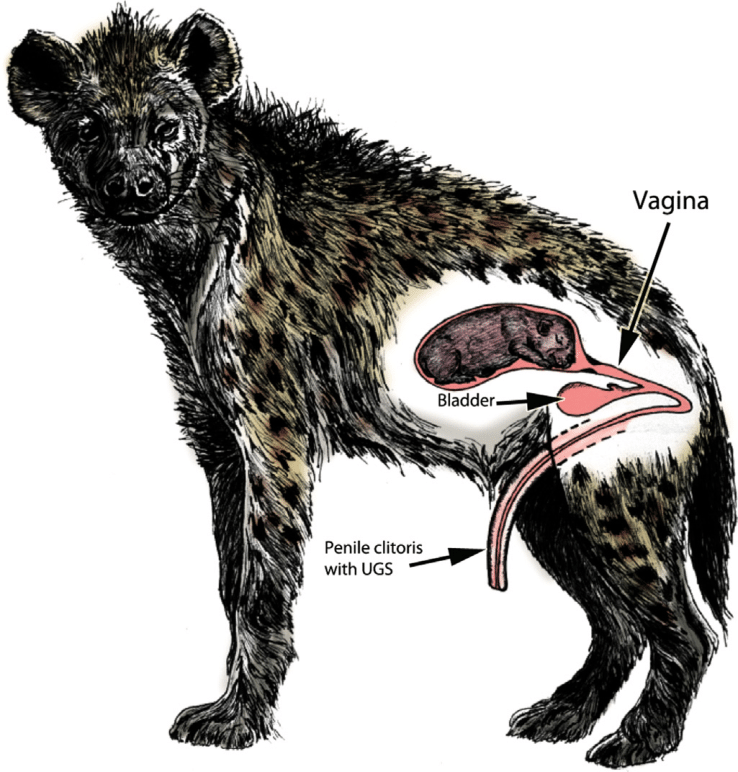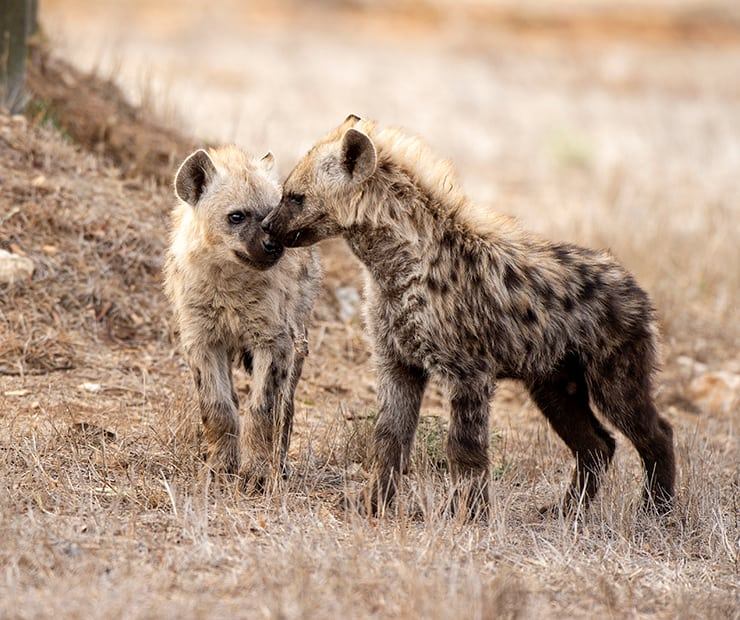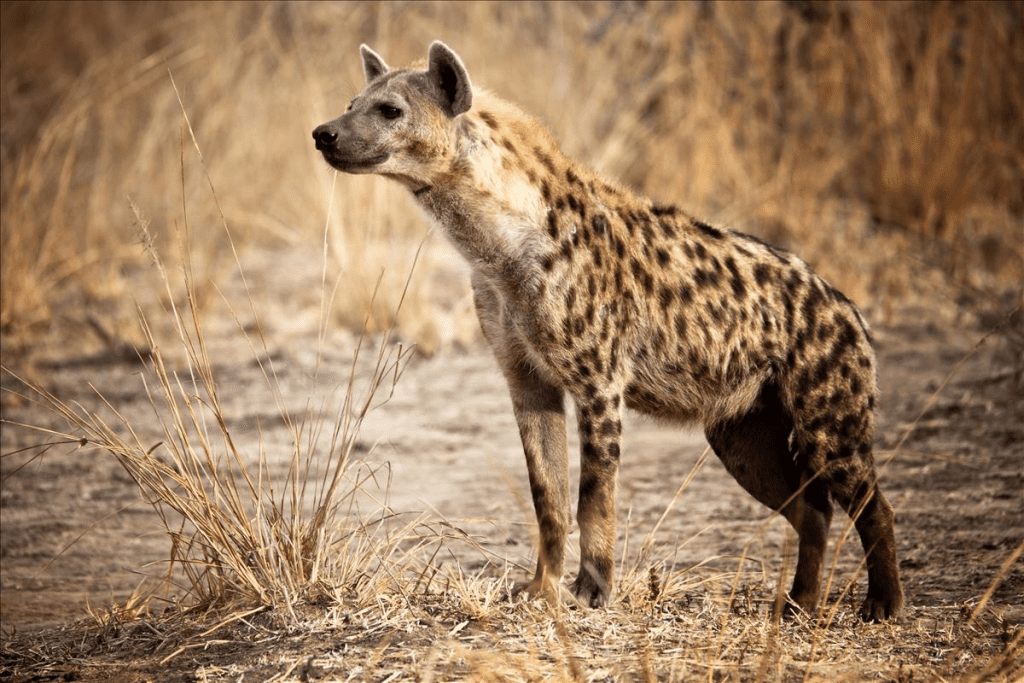Nature is full of fascinating and sometimes brutal adaptations, but few are as shocking as the birthing process of the spotted hyena. You might think childbirth is a universally painful experience, but hyenas take it to an entirely new level.
Female hyenas have one of the most unusual reproductive anatomies in the animal kingdom—what appears to be a penis is actually an elongated clitoris, known as a pseudo-penis. This rare adaptation makes mating, birth, and survival incredibly difficult for both mother and cubs.
Let’s dive into the science, struggles, and evolutionary mysteries behind why hyenas experience one of the most challenging births in the wild.
Hyenas’ Unique Reproductive Anatomy: A Bizarre Evolutionary Twist

The female spotted hyena (Crocuta crocuta) is unlike any other mammal when it comes to reproduction. Unlike most female mammals, hyenas have no external vaginal opening. Instead, their labia are fused together, forming a pseudo-scrotum, and their clitoris is elongated into what resembles a fully functional penis.
This means that both mating and giving birth happen through a narrow, tough, and inflexible canal—a structure that poses serious risks to both mother and cubs.
But why would evolution favor such an extreme adaptation? The answer lies in hyena social structure and dominance.
The Link Between Dominance and Reproductive Anatomy
Hyenas live in strict matriarchal societies, where females outrank males in dominance. The unusual reproductive anatomy is believed to be an evolutionary adaptation linked to social hierarchy.
- A Display of Strength: A larger pseudo-penis might act as a dominance signal, making it clear which females hold power in the clan.
- Hormonal Influence: Female hyenas have higher testosterone levels than males, leading to increased aggression and dominance over the pack.
- Mating Challenges: Males must earn the right to mate, as females control copulation with their complicated anatomy.
Video : Hyenas’ Brutal Birth: The Most Painful Labor in the Animal Kingdom
While this system gives females power, it comes at a terrible cost when it’s time to give birth.
Why Giving Birth Is So Dangerous for Hyenas
Imagine trying to push a newborn through a passage too small, too rigid, and highly prone to tearing. That’s exactly what female hyenas go through every time they give birth.
Here’s what makes hyena birth so deadly:
- A Super Tight Birth Canal
- The pseudo-penis acts as the only birth canal, but it is long, narrow, and lacks the elasticity of a normal vagina.
- This makes labor extremely difficult and painful, with a high chance of the tissue tearing.
- First-Time Mothers Face the Worst Risks
- Many first-time mothers do not survive the birthing process due to severe ruptures.
- Those who do survive often suffer from long-term damage to their reproductive organs.
- High Cub Mortality Rate
- A staggering 60% of hyena cubs suffocate before they are fully delivered.
- Since the birth canal is so tight, cubs often become trapped and die before they can emerge.
- A Painful Recovery Process
- After birth, the pseudo-penis often ruptures completely, forcing it to heal over time.
- Mothers suffer weeks of pain and vulnerability while their bodies recover.
Despite these brutal challenges, hyenas continue to thrive, and their unique reproductive system has remained largely unchanged for millions of years.
How Do Hyenas Mate? The Struggles of Reproduction

If you think birth is difficult for hyenas, mating is no easier. Males must overcome significant anatomical and social obstacles just to reproduce.
- Males Are Submissive to Females
- Unlike in many species where males dominate, male hyenas are the weaker sex in both power and ranking.
- They must approach females cautiously, often displaying submissive behavior to gain approval.
- Navigating the Pseudo-Penis
- Since females have no traditional vaginal opening, males must carefully maneuver through the pseudo-penis to copulate successfully.
- This requires both patience and precise positioning, making it one of the most complex mating processes in the animal world.
- Only the Strongest Males Get to Reproduce
- Males don’t fight each other for dominance like in other species. Instead, they must earn the female’s trust over time.
- Females choose mates based on persistence, patience, and respect, ensuring only the most determined males pass on their genes.

Given how dangerous and inefficient the reproductive process is for hyenas, one might wonder why evolution hasn’t corrected this issue.
The answer lies in survival strategy and social dynamics.
- Matriarchal Control Guarantees Stronger Cubs
- By limiting mating to only the most persistent males, female hyenas ensure that their cubs inherit strong genetics.
- This method prevents weaker genes from spreading, keeping the species robust.
- Higher Testosterone Helps With Survival
- The same high testosterone that makes birth difficult also makes female hyenas stronger and more aggressive.
- This aggression helps protect their cubs and maintain dominance in their environment.
- Fewer Cubs = More Resources
- Since many cubs don’t survive birth, the ones that do are often given more attention and resources.
- This ensures the strongest cubs make it to adulthood, increasing the clan’s overall survival rate.
The Resilience of the Spotted Hyena
Despite their brutal birthing process, hyenas have thrived for millions of years. Their ability to adapt, dominate, and survive proves just how powerful evolutionary trade-offs can be.
- They are among Africa’s most successful predators, competing with lions for food.
- Their clans are ruled by powerful females, ensuring only the strongest members survive.
- They have some of the most advanced social structures in the animal kingdom, making them highly intelligent and strategic.
Video : The Most Extreme Births In The Animal Kingdom
Conclusion: Nature’s Ultimate Test of Survival
Hyenas are proof that nature often prioritizes survival over comfort. Their unique reproductive anatomy, extreme birthing challenges, and dominance-driven society have allowed them to thrive despite overwhelming odds.
While their birth process remains one of the most painful and deadly in the animal kingdom, it also ensures that only the strongest females and cubs survive.
So the next time you see a spotted hyena, remember—they’re not just fierce scavengers. They’re survivors of one of evolution’s toughest reproductive challenges.
O filho pequeno do meu vizinho veio nadar na nossa piscina – quando ele tirou a camisa e eu vi suas costas, fiquei sem palavras

Uma pergunta inocente do filho do meu vizinho me levou por um caminho que eu nunca esperava. O que descobri sobre meu marido me deixou sem fôlego, e eu sabia que minha vida estava prestes a tomar uma guinada brusca que eu nunca imaginei.
Um sábado comum. Eu estava no quintal, com os joelhos afundados na minha pequena selva de ervas daninhas, aproveitando o sol do início da tarde quando avistei Dylan, o filho do meu vizinho, subindo a entrada da garagem. Ele tinha nove, talvez dez anos, e era o tipo de criança que não pedia muito, mas sempre tinha essa determinação silenciosa sobre ele.

Um menino caminhando na calçada | Fonte: Midjourney
Ele tinha o mesmo olhar agora enquanto caminhava em minha direção, com as mãos enfiadas nos bolsos e os olhos baixos.
“Oi, Srta. Taylor,” Dylan murmurou, ficando a alguns metros de distância. Ele não costumava ser tão tímido, o que imediatamente chamou minha atenção.
Limpei a sujeira das minhas mãos e dei um sorriso para ele. “E aí, Dylan! O que houve? Está tudo bem?”
Ele mudou de um pé para o outro, ainda evitando meu olhar. “Uh, sim… hum, desculpe incomodar, mas você acha que eu poderia nadar na sua piscina um pouco?”

Mulher conversando com um menino | Fonte: Midjourney
A pergunta me pegou de surpresa. Dylan nunca tinha pedido para nadar na minha piscina antes, mas não era incomum que as crianças da vizinhança ficassem por ali. Imaginei que talvez ele estivesse apenas procurando algo para fazer. Sua mãe, Lisa, não ficava muito em casa, e ele passava a maior parte do tempo sozinho.
“Claro! Você sabe que é bem-vindo a qualquer hora”, eu disse, olhando para a piscina. “Está bem quente lá fora. Você vai se sentir melhor se refrescando. Quer uma limonada também?”
Dylan balançou a cabeça, um pequeno sorriso brincando em seus lábios. “Não, obrigado.”

Um jovem rapaz em pé ao lado de uma piscina | Fonte: Midjourney
Eu o observei caminhar até a piscina, colocando sua toalha em uma das espreguiçadeiras. Algo parecia… estranho. Não de uma forma assustadora e assustadora, mas apenas o suficiente para um pequeno nó se formar no meu estômago. Eu ignorei, dizendo a mim mesma que eu estava apenas sendo superprotetora. Ele é um bom garoto , eu me lembrei.
Decidi pegar um copo de limonada para ele de qualquer forma. Estava quente demais para ele não se manter hidratado. Entrei, servi um copo e voltei para fora, bem a tempo de vê-lo tirando a camisa.
Foi aí que tudo mudou.
Eu congelei. Congelei completamente.

Um jovem nadando | Fonte: Midjourney
O copo escorregou da minha mão, quebrando-se aos meus pés. Meu coração batia forte e eu mal conseguia respirar.
Nas costas de Dylan havia uma marca de nascença distinta — uma forma grande e irregular logo abaixo da escápula.
Aquela marca de nascença era muito familiar. Meu marido tinha exatamente a mesma. Mesma forma, mesmo lugar. Minha mente não conseguia processar. Eu me sentia como se estivesse em um sonho ruim do qual não conseguia acordar.

Mulher surpreendida | Fonte: Midjourney
“Dylan”, chamei, com a voz trêmula.
Ele ergueu os olhos da piscina, com água pingando do seu cabelo. “Sim?”
Engoli em seco, apontando vagamente para ele, tentando manter minha voz firme. “Essa marca nas suas costas… há quanto tempo você a tem?”
Dylan piscou, confuso. “Huh? Ah, a marca de nascença? Minha mãe diz que eu tenho desde que era um bebê. Por quê?”
Senti o sangue sumir do meu rosto. Tentei sorrir, agir normalmente, mas meu interior estava se revirando. “Sem motivo. Só… curiosidade.”

Mulher em pé ao lado da piscina | Fonte: Midjourney
Ele deu de ombros e voltou a chapinhar na piscina, completamente inconsciente do pânico que me arranhava. A mesma marca de nascença . A voz do meu marido ecoou na minha cabeça de anos atrás, brincando sobre o quão rara ela era, como parecia algum tipo de estrela manchada. Agora eu estava olhando para ela em outra pessoa — em Dylan.
Virei-me rapidamente, não querendo que Dylan visse o medo, a confusão, a raiva borbulhando. Eu precisava de respostas, mas por onde eu poderia começar?
Naquela noite, eu andava de um lado para o outro na sala de estar, roendo as unhas, incapaz de ficar parada. Meu marido estava na cozinha, alheio ao caos dentro de mim.

Mulher em pensamentos profundos sentada em sua sala de estar | Fonte: Midjourney
“Taylor, está tudo bem?” ele gritou. “Você está andando de um lado para o outro há uma hora.”
Eu pulei com a voz dele, tentando agir casualmente. “Uh, sim… só… pensando em algumas coisas.”
Ele levantou uma sobrancelha, mas não insistiu. Meu coração batia forte. Eu não podia perguntar a ele, ainda não. Não sem provas.
Mais tarde, quando ele se preparou para dormir, eu o observei como um falcão. Quando ele foi ao banheiro para tomar banho, eu me movi rapidamente, pegando seu pente da mesa de cabeceira. Meus dedos tremeram enquanto eu puxava alguns fios de seu cabelo. Eu os enfiei em um saco plástico e os enfiei na minha bolsa assim que ele voltou para o quarto.

Saco plástico com fios de cabelo | Fonte: Midjourney
“Você vem para a cama?”, ele perguntou, passando uma toalha pelos cabelos.
“Sim, em um minuto”, murmurei, minha mente a mil.
Felizmente, na manhã seguinte, Dylan pediu para nadar na minha piscina novamente, e enquanto estava lá, eu agarrei alguns fios de cabelo dele da toalha enquanto ele estava distraído com seu mergulho. A culpa me agarrou, mas eu tinha que saber.
Dias depois, enquanto eu estava sentado à mesa da cozinha, com os resultados do DNA em minhas mãos trêmulas, eu mal conseguia respirar. Abri o envelope, meu coração batendo forte.
E lá estava. 99,9% de correspondência.
Deixei o papel cair e fiquei olhando fixamente para o chão.

Envelope no chão | Fonte: Midjourney
A traição me atingiu como uma tonelada de tijolos, mas eu não estava prestes a desmoronar. Eu tinha passado anos sem saber vivendo ao lado da mulher com quem meu marido me traiu, vendo seu filho crescer bem na minha frente, e eu não tinha ideia. Minha vida, meu casamento — era tudo uma mentira. Mas eu não iria desmoronar. Não, eu tinha algo muito mais satisfatório em mente.
Eu queria que ele pagasse. Não apenas com uma discussão ou uma briga. Não, eu queria que ele sentisse o mesmo choque, a mesma devastação, que eu senti quando abri aquele envelope.

Mulher estressada sentada no sofá | Fonte: Midjourney
No fim de semana seguinte, decidi fazer um “churrasco de bairro”. Convidei Lisa e meu marido. Nenhum dos dois sabia que o outro viria. O plano era simples. Eu interpretaria a esposa perfeita e desavisada, toda sorrisos e calor, até o momento em que revelasse a verdade.
O sábado chegou, e eu cumprimentei Lisa na porta com um sorriso amigável, agindo como se tudo estivesse ótimo. Meu marido chegou logo depois, sem saber. Ele beijou minha bochecha, alheio ao que eu tinha reservado para ele. Eu sorri de volta, sentindo a fria satisfação borbulhando dentro de mim.

Casal sorrindo um para o outro | Fonte: Midjourney
Nós três nos sentamos à mesa no quintal. Eu servi a comida, meu coração disparado, mas minhas mãos firmes. O ar estava pesado de tensão, mas nenhum deles pareceu notar. Lisa fez uma pequena conversa sobre Dylan, e meu marido entrou na conversa com seu charme habitual, mas eu não estava ouvindo. Eu estava esperando.
Servi-me de uma taça de vinho, tomei um gole e a coloquei de lado com uma calma que eu realmente não sentia. Então, casualmente, soltei a bomba.
“Então, recebi os resultados de um teste de DNA recentemente”, eu disse, recostando-me na cadeira. “Algo interessante surgiu.”

Pessoas sentadas no quintal | Fonte: Midjourney
Silêncio. O ar pareceu congelar. Eu vi a cor sumir do rosto do meu marido. Ele sabia. Ah, ele sabia.
O garfo de Lisa caiu no prato, seus olhos arregalados disparando entre mim e meu marido. “O-Do que vocês estão falando?” ela gaguejou, sua voz quase um sussurro.
Dei-lhe um sorriso frio. “Você sabe exatamente do que estou falando, Lisa.”
A mão do meu marido apertou a bebida, mas ele não disse nada, seu rosto pálido como um fantasma. Ele sabia que não havia como sair dessa.

Pessoas sentadas no quintal | Fonte: Midjourney
Levantei-me lentamente, meu coração batendo rápido, mas minha voz firme como aço. “Arrume suas coisas”, eu disse, olhando-o fixamente nos olhos. “E saia. Eu fico com a casa. E nem pense em brigar comigo por isso — eu já falei com um advogado.”
Ele abriu a boca para falar, mas nenhuma palavra saiu. Ele olhou para mim, depois para Lisa, o pânico em seus olhos crescendo a cada segundo.
Eu não tinha terminado. “Ah, e só para você saber”, acrescentei, minha voz cheia de satisfação, “gravei essa conversa inteira. Não só para mim, mas para mostrar ao mundo quem você realmente é.”

Mulher decepcionada | Fonte: Midjourney
Seu rosto passou de branco a vermelho, mas antes que ele pudesse dizer qualquer coisa, virei as costas para ele e entrei em casa.
Em uma semana, ele se foi — sem casa, sem família, sem reputação. Lisa? Ela se mudou logo depois, envergonhada e humilhada. Dylan? Eu senti por ele. Ele era apenas um garoto inocente pego no fogo cruzado da traição de seus pais. Eu não podia puni-lo por seus pecados. Então, criei um fundo fiduciário para ele. Um que seu pai nunca tocaria.

Um jovem rapaz em pé ao ar livre | Fonte: Midjourney
No final, não foi só o karma que o pegou. Fui eu.
E enquanto eu o observava indo embora pela última vez, eu não senti tristeza. Eu não me senti culpado. Eu senti paz.
A última coisa que ele me disse?
“Taylor… como você pôde?”
Eu sorri. “Como eu pude? Você me diz.”

Homem e mulher conversando enquanto estão ao lado de um carro | Fonte: Midjourney
Se você gostou desta história, você pode gostar desta também: Nossos vizinhos ficaram chocados quando compramos esta casa – Acontece que havia uma verdade que não sabíamos. Clique aqui para ler a história completa.
Este trabalho é inspirado em eventos e pessoas reais, mas foi ficcionalizado para fins criativos. Nomes, personagens e detalhes foram alterados para proteger a privacidade e melhorar a narrativa. Qualquer semelhança com pessoas reais, vivas ou mortas, ou eventos reais é mera coincidência e não intencional do autor.
O autor e a editora não fazem nenhuma reivindicação quanto à precisão dos eventos ou à representação dos personagens e não são responsáveis por nenhuma interpretação errônea. Esta história é fornecida como está”, e quaisquer opiniões expressas são as dos personagens e não refletem as opiniões do autor ou da editora.



Leave a Reply